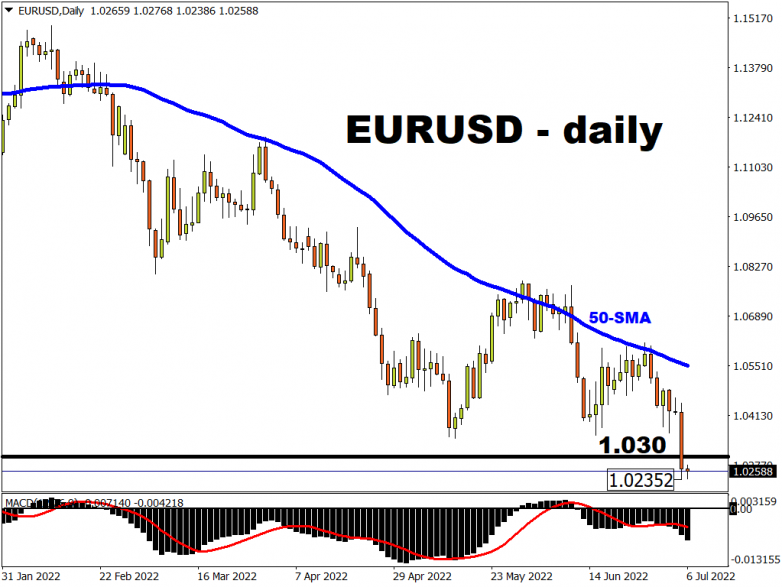EURUSD has been slammed by reduced bets surrounding the European Central Bank’s intended rate hikes, amid a souring economic outlook for the Eurozone.
The world’s most-traded currency pair sank below 1.03 for the first time since December 2002, and is still languishing around that two-decade low at the time of writing.

Using 2002’s price action as a reference point, should this downtrend persist, the next level of support can be drawn at the July 2002 peak of 1.02, with the November 2002 peak lingering close by at 1.017.
When could EURUSD hit parity?
Markets currently point to a greater-than-even chance (57.2% to be more precise) that EURUSD could touch the 1.000 mark sometime in Q3.
Those odds climb higher to a 66% chance of EURUSD reaching parity sometime over the next six months.
And markets believe this downtrend is set to continue for longer: 25-delta risk reversals are at the most bearish positioning since March on EURUSD’s 3- and 6-month outlooks.
Recall that back in March 2022, the Fed triggered its first rate hike since 2018, while the ECB still lags behind – slated to only raise rates two weeks from now at its policy meeting on July 21st. That widening policy gap, which was already evident in the markets since Q1, sent EURUSD tumbling by over 3% in the first week of March.
Why is the euro sinking?
Markets are growing increasingly pessimistic about the Eurozone’s economic outlook.
- The bloc could face an energy crisis if Russia cuts off its gas supplies to Germany, Europe’s largest economy, which would be a blow to the gut for its industrial sector. Already, the likes of Uniper SE is set to receive a government bailout due to its ailing prospects.
- As such, the looming economic woes is hampering the European Central Bank’s ability to raise interest rates beyond the 25-basis point hike slated for later this month, with an expected total of 135bps in hikes by the end of this year. The ECB’s 135bps still lags the 150bps in hikes that the Fed has already triggered so far this year, with much more to come. The FOMC could raise its benchmark rates by another 75bps just this month alone, further widening the yields spread between US and European bonds.
- Even if the ECB presses ahead with its intended rate hikes to quell red-hot inflation, such policy tightening not only sours the Eurozone’s economic outlook, but also raises the prospects of fragmentation risks. A widening yields gap between the bloc’s more economically vulnerable members in the south such as Italy, versus its economic bedrocks such as Germany, threatens to rip the fabric of the Eurozone once more, invoking memories of the sovereign debt crisis from over a decade ago.
With investors and traders only all too aware of these downside risks for the Eurozone economy, no surprise then of the euro’s weakness, with its downtrend against the US dollar set to persist for the rest of 2022 at least.

